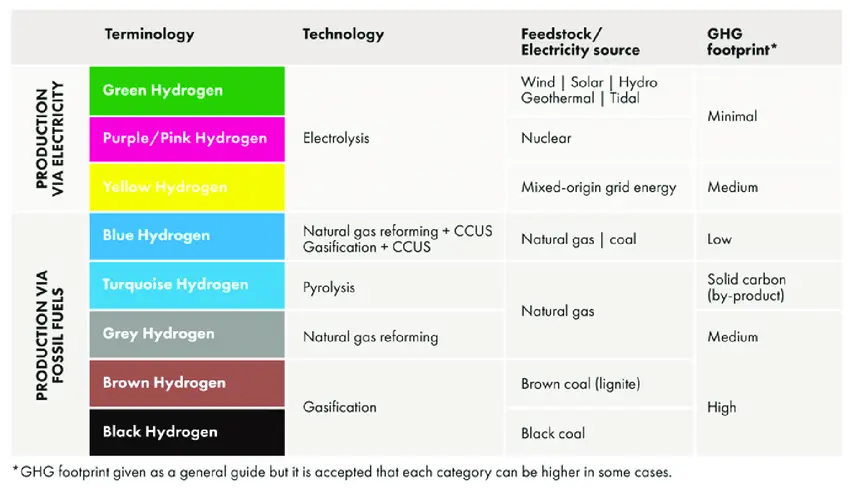
Introduction
Hydrogen is the lightest and simplest element in the periodic table (Atomic number 1). It is also the most abundant element in the universe. The main problem with Hydrogen is that it seldom exists alone in pure form. The element is highly reactive and can form bonds with many elements forming compounds like water (H2O) or methane (CH4).
Now, here’s where the intrigue begins – hydrogen is not a plug-and-play fuel, it is an energy carrier which means it needs to be extracted first unlike petroleum which can be used directly as a fuel. To use Hydrogen as a fuel, it needs to be obtained in pure form, this is done by splitting molecules of water or methane.
As we fast-forward into the future, hydrogen emerges as a key energy source as the world transitions away from fossil fuels. Hydrogen is versatile – it can be used as a fuel for transportation, electricity generation, and industrial processes, and also for long-term energy storage (IEA, 2021). But, and there’s always a but, most hydrogen today comes from not-so-green sources like natural gas or coal, giving rise to unwanted carbon emissions.
Methods of Hydrogen Production
- Steam methane reforming (SMR) of natural gas: In this method, hydrogen is separated from hydrocarbons with the help of steam at high temperatures. It’s cost-effective, but it leaves a carbon footprint, which might not align with our environmental goals.
- Coal gasification: In this method, hydrogen is extracted from coal through partial oxidation. It is again cost-effective but leaves significant carbon emissions.
- Electrolysis – The Green Pioneer: A transformative process where electricity splits water into hydrogen and oxygen. If this electricity comes from renewable sources, it results in green hydrogen, free from carbon emissions. This method stands out as an eco-friendly contender.
- Biomass Gasification: It is a proven technology that converts biomass (such as agricultural crop residue, solid waste, etc.) into hydrogen through a controlled process without combustion using heat, steam, and oxygen. Growing biomass removes carbon dioxide from the atmosphere, this method can have minimal net carbon emissions, especially when combined with long-term carbon collection, usage, and storage (CCUS).
- Biomass Pyrolysis: This method emerges as a technological alternative generating a mix of liquid organic products, gases, and carbonaceous residue without using any oxidants. Though less popular, it holds promise, especially for liquid biofuel production.
Companies in the US are leading the development of biomass gasification, with India actively exploring biomass-based technologies. Reliance, for instance, successfully tested the gasification of torrefied biomass for hydrogen production, aiming to showcase its potential by producing 18 kt/y (kilotonnes/ year). Indian Oil Corporation and the Indian Institute of Science have been developing a plant (88t/ y) for hydrogen production using biomass gasification (using steam and oxygen as oxidants). As part of its Green Hydrogen incentive scheme, the Indian Government has earmarked funds to support 40kt/ y of biomass-derived hydrogen production capacity.
Real-Life Marvels: Green Hydrogen in Action
In the quest for sustainable energy, green hydrogen emerges as a real-life superhero, transforming how hospitals worldwide power their operations.
- Rjinstata Hospital, Netherlands
At Rjinstata Hospital, a groundbreaking approach to energy independence unfolds. Using photovoltaic (PV) panels, the hospital not only meets its electricity needs but goes beyond. The surplus solar energy is being used in the production of green hydrogen through electrolysis. The excess hydrogen is stored in fuel cells, ready to be used as reserve power when needed. - Viamed San Jose Hospital, Spain
Across the borders, in Spain, Viamed San Jose Hospital embraces the power of electrolysis. Here, hydrogen is produced through this eco-friendly process, and its applications extend beyond conventional energy use. In a brilliant dual-purpose strategy, the hospital channels this green hydrogen into its boiler, serving as a sustainable heating solution. The oxygen generated as a byproduct of electrolysis is used in critical medical procedures, turning waste into a valuable resource.
These hospitals stand as living examples, showcasing the versatility of green hydrogen beyond traditional energy applications.
Classification of Hydrogen based on fuel used
Hydrogen has been categorized by the method of production. The same has been summarized well in the below figure.

Black and Brown hydrogen uses coal and lignite to produce hydrogen from water, emitting carbon dioxide and methane in the process. Grey is derived from methane and water, producing carbon dioxide with some methane that escapes in the process. Like grey hydrogen, Blue hydrogen is made from methane, but the carbon dioxide is stored underground and does not escape into the atmosphere. Pink/ Purple hydrogen uses nuclear power to produce hydrogen. Green hydrogen uses renewable sources of energy to generate hydrogen from water.
Apart from these, there is also a White Hydrogen which represents the rare, naturally occurring hydrogen. A new variant called Emerald and Turquoise Hydrogen is also being explored where the hydrogen is produced from hydrocarbons like methane in the absence of oxygen. This produces solid carbon which is useful in numerous ways.
Green Hydrogen Production: Electrolysis Process
To read the full article, please subscribe to PRUDENT Ideas Membership!
See you next time.
Until then… Stay Prudent!
Disclaimer: This article is provided for informational purposes only and any companies discussed here should not be considered investment advice
Also, read:
Awesome gathered information brother. This is just wow
Thank you so much🙏
Amazing stuff – request you to please explore Biodiesel opportunity as well, considering the reneweables theme above as alternative fuel sources
Sure, we’ll try to explore that as well.
Where is the cup and handle you were talking about in twitter??
Balu Forge
https://www.hydrogeninsight.com/production/nobody-wants-to-pay-for-it-exxonmobil-and-aramco-ceos-say-green-hydrogen-is-too-expensive-to-replace-fossil-fuels/2-1-1614462
Hi guys. Came across this news. Just out of curiosity, will this hype of green hydrogen will follow the same chart as suzlon energy? 400rs to 40 (i bought at this price) to 4 ( sold at this price) to 40rs (now). As much as i can understand the energy production from wind (very high maintenance cost, esp offshore wind) and hydrogen as you see the in the link above is very expensive. Anyways all constructive feedbacks are appreciated.
The major issue with the renewable sources incl. wind and solar is that both are intermittent. Despite significant advancements and cost reductions in renewable and hydrogen technologies over the past decade, they have yet to reach cost parity with fossil fuels.
There are three probable solutions to make Hydrogen feasible:
1. Hydrogen produced using CCUS where the hydrogen cost can be offset by selling solid carbon obtained as by-product.
2. Capillary-fed electrolysers which is being claimed to increase efficiency of the electrolysers to 95% without increasing the cost.
3. Natural Hydrogen deposits doesn’t rely on renewable energy sources, extraction and transformation cost, no CO2 storage cost, and is said to replenish itself. This could be a game changer until other production methods achieve greater efficiency.